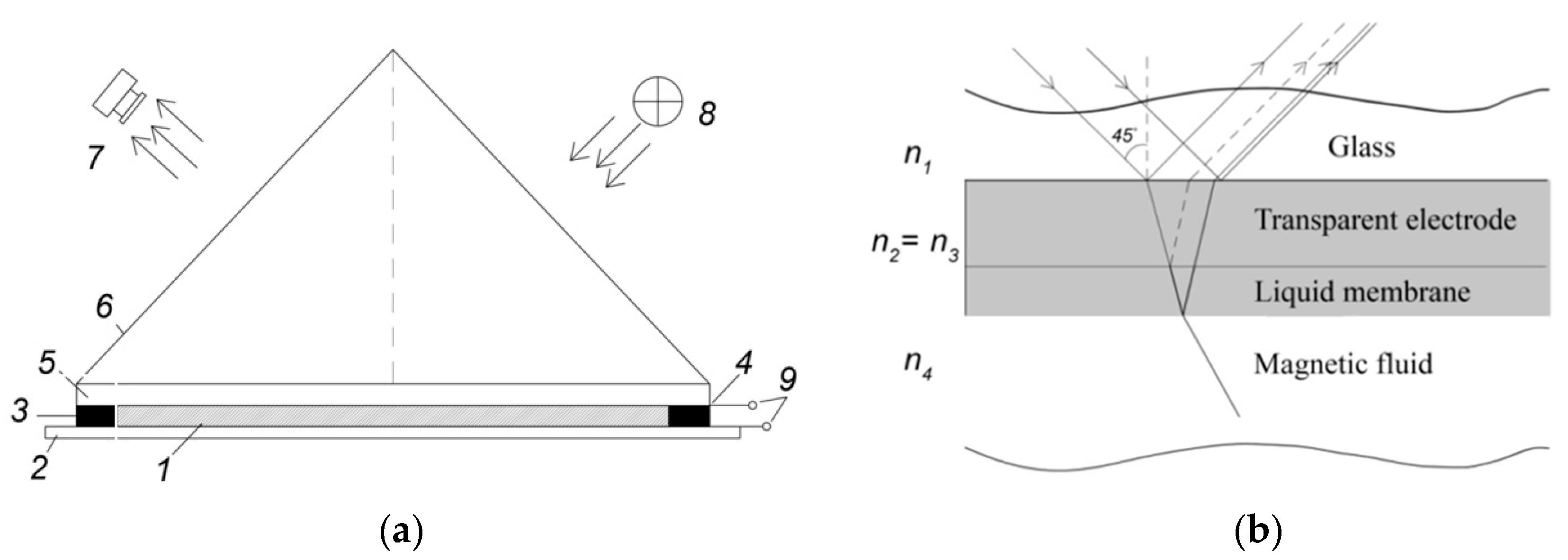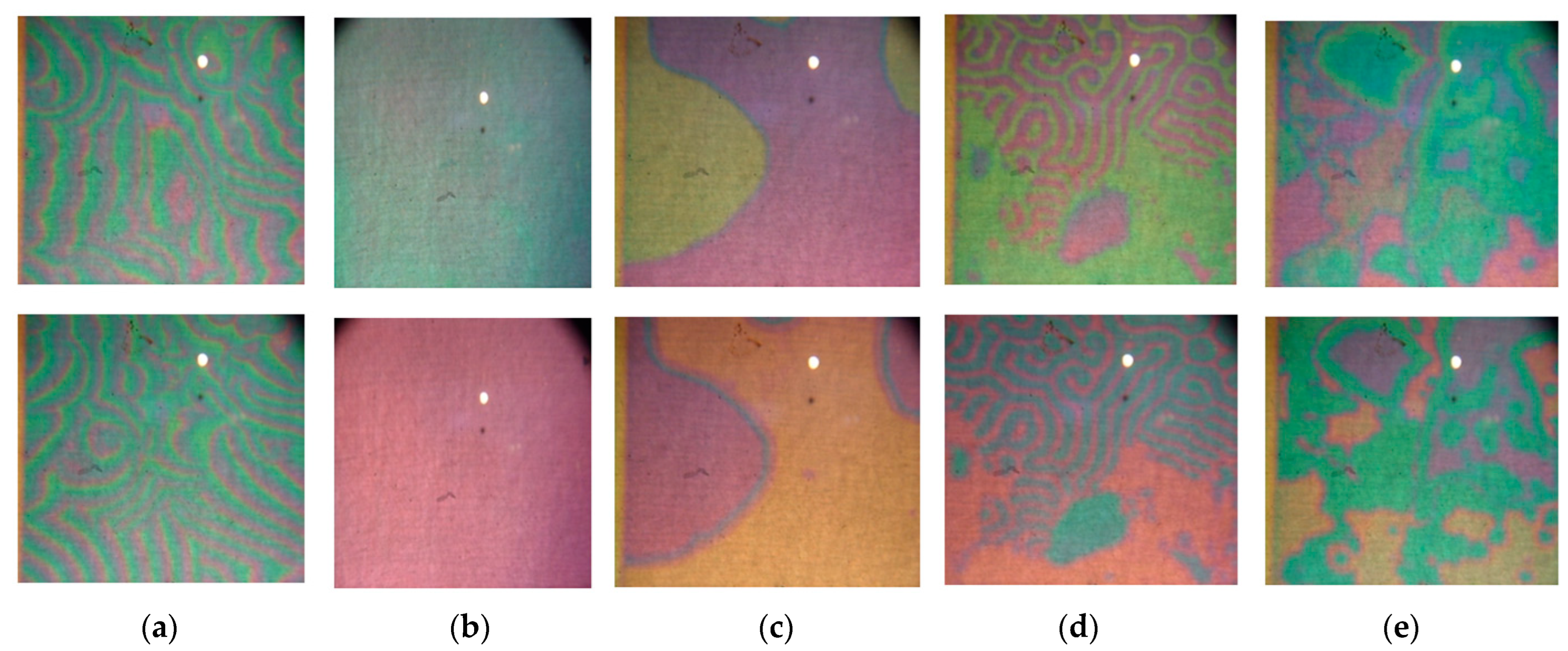Experimental and Theoretical Study of Forced Synchronization of Self-Oscillations in Liquid Ferrocolloid Membranes
Abstract
1. Introduction
2. Materials and Methods: Experimental Technique
3. Discussion of Experimental Results
4. Mathematical Model of Forced Synchronization of an Autowave Process in a Ferrocolloid
5. Results of the Implementation of the Mathematical Model (Computer Experiment)
6. Conclusions
- The action of an external periodic force on an autowave in a ferrocolloid led to a change in the frequency of observed autowaves. If the frequency detuning was small, then the natural frequency of the autowaves ω0 became equal to the frequency of the external force ωp or proportional to it.
- The periodic application of electrical force transformed spiral waves. Since the reverberator rotated at a variable speed, the frequency of its rotation was modulated.
- A sequence of frequency-blocked modes was observed by changing the frequency of external periodic exposure. The structures obtained experimentally in a cell with a ferrocolloid under the action of an external periodic force are similar to those described in [24], where the same structures were observed by the authors in a quasi-two-dimensional reaction-diffusion system with a light-sensitive Belousov-Zhabotinsky reaction. This result is convincing evidence that the phenomenon of synchronization when pairing the internal oscillatory dynamics with an external periodic action can arise in a variety of chemical, biological, and other systems [41,42,43,44,45,46].
- A mathematical model of the synchronization of self-oscillations was developed as a boundary value problem for a nonlinear system of partial differential equations, and a numerical solution was obtained. The frequency capture of autowaves by an external periodic force was confirmed in a computer experiment, which shows the adequacy of the developed model. Mathematical modeling of autowave synchronization confirmed the fact that a complex of coupled nonlinear oscillators can exhibit spatial reorganization under the influence of an external periodic action.
Author Contributions
Funding
Institutional Review Board Statement
Informed Consent Statement
Data Availability Statement
Acknowledgments
Conflicts of Interest
References
- Dikansky, Y.I.; Ispiryan, A.G.; Arefyev, I.M.; Kunikin, S.A. Effective fields in magnetic colloids and features of their magnetization kinetics. Eur. Phys. J. E 2021, 44, 2. [Google Scholar] [CrossRef] [PubMed]
- Dikansky, Y.I.; Bedzhanyan, M.A.; Kolesnikova, A.A.; Gora, A.Y.; Chernyshev, A.V. Dynamic Effects in a Magnetic Fluid with Microdrops of Concentrated Phase in a Rotating Magnetic Field. Tech. Phys. 2019, 64, 337–341. [Google Scholar] [CrossRef]
- Ryapolov, P.A.; Sokolov, E.A.; Postnikov, E.B. Behavior of a gas bubble separating from a cavity formed in magnetic fluid in an inhomogeneous magnetic field. J. Magn. Magn. Mater. 2022, 549, 169067. [Google Scholar] [CrossRef]
- Bashtovoi, V.G.; Reks, A.G.; Motsar, A.A. On shapes and stability of the magnetic fluid surface in uniform magnetic field. Magnetohydrodynamics 2019, 55, 271–277. [Google Scholar] [CrossRef]
- Pelevina, D.A.; Sharova, O.A.; Merkulov, D.I.; Turkov, V.; Naletova, V. Spherical magnetizable body partially immersed in a magnetic fluid in a uniform magnetic field. J. Magn. Magn. Mater. 2022, 494, 165751. [Google Scholar] [CrossRef]
- Rosensweig, R.E. Ferrohydrodynamics; Cambrige University Press: Cambridge, UK, 1985; p. 344. [Google Scholar]
- Nechifor, A.; Stoian, M.; Voicu, Ş.I.; Nechifor, G. Modified Fe3O4 colloidal dispersed magnetic particles as carrier in liquid membranes. Optoelectron. Adv. Mater. Rapid Commun. 2010, 4, 1118–1123. [Google Scholar]
- Chekanov, V.V.; Kandaurova, N.V.; Chekanov, V.S. Calculation of the membrane thickness of magnetite nanoparticles on the surface of the transparent conductive electrode in the electric field. J. Nano-Electron. Phys. 2015, 7, 04041. [Google Scholar]
- Pérez, A.D.; Van der Bruggen, B.; Fontalvo, J. Modeling of a liquid membrane in Taylor flow integrated with lactic acid fermentation. Chem. Eng. Proc. 2019, 144, 107643. [Google Scholar] [CrossRef]
- Chekanov, V.V.; Kovalenko, A.V. Experimental and Theoretical Study of an Autowave Process in a Magnetic Fluid. Int. J. Mol. Sci. 2022, 23, 1642. [Google Scholar] [CrossRef]
- Ivanov, A.O.; Zubarev, A. Chain formation and phase separation in ferrofluids: The influence on viscous properties. Materials 2020, 13, 3956. [Google Scholar] [CrossRef]
- Chekanov, V.S.; Kirillova, E.V.; Kovalenko, A.V.; Diskaeva, E.N. Experimental study and mathematical modelling of self-oscillation at the electrode-magnetic fluid interface in an electric field. Cond. Mat. Int. 2021, 23, 626–636. [Google Scholar] [CrossRef]
- Chekanov, V.V.; Kandaurova, N.V.; Chekanov, V.S. Phase autowaves in the near-electrode layer in the electrochemical cell with a magnetic fluid. J. Magn. Magn. Mater. 2017, 431, 38–41. [Google Scholar] [CrossRef]
- Mallphanov, I.L.; Vanag, V.K. Chemical micro-oscillators based on the Belousov-Zhabotinsky reaction. Rus. Chem. Rev. 2021, 90, 1263–1286. [Google Scholar] [CrossRef]
- Kudryashova, N.; Nizamieva, A.; Tsvelaya, V.; Panfilov, A.V.; Agladze, K.I. Self-organization of conducting pathways explains electrical wave propa-gation in cardiac tissues with high fraction of nonconducting cells. PLoS Comput. Biol. 2019, 15, e1006597. [Google Scholar] [CrossRef]
- Davydov, V.A.; Davydov, N.V. The propagation of autowaves in capillaries filled with a moving viscous excitable medium. Biophysics 2015, 60, 269–273. [Google Scholar] [CrossRef]
- Sidorova, A.E.; Malyshko, E.V.; Tverdislov, V.A.; Levashova, N.T. Autowave Self-Organization in the Folding of Proteins. Mosc. Univ. Phys. Bull. 2019, 74, 213–226. [Google Scholar] [CrossRef]
- Kozhevnikov, V.M.; Chuenkova, I.; Danilov, M.I.; Yastrebov, S.S. Voltage self-sustained oscillation and phase separation dynamics in a thin layer of a weakly conducting ferromagnetic liquid with periodically emerging electrohydrodynamic flows. Tech. Phys. 2008, 53, 192–198. [Google Scholar] [CrossRef]
- Kozhevnikov, V.M.; Chuenkova, I.Y.; Danilov, M.I.; Yastrebov, S.S. Dynamics of self-organization in a thin layer of a magnetic fluid placed in a constant electric field. Tech. Phys. 2006, 51, 946–948. [Google Scholar] [CrossRef]
- Pikovsky, A.S.; Rosenblum, M.G.; Kurts, Y. Synchronization: A Universal Concept in Nonlinear Sciences; Cambridge University Press: New York, NY, USA, 2003; p. 396. [Google Scholar]
- Landa, P.S. Nonlinear Vibrations and Waves in Dynamical Systems; (MAIA book series); Springer: Berlin/Heidelberg, Germany, 1996; p. 533. [Google Scholar]
- Awrajcewicz, J. Deterministic Vibrations of Discrete Systems; WNT: Warsaw, Poland, 1996. [Google Scholar]
- Awrajcewicz, J.; Krysko, W.A. Vibrations of Continuous Systems; WNT: Warsaw, Poland, 2000. [Google Scholar]
- Petrov, V.; Ouyang, Q.; Swinney, H.L. Resonant pattern formation in a chemical system. Nature 1997, 388, 655–657. [Google Scholar] [CrossRef]
- Chekanov, V.V.; Kandaurova, N.V.; Chekanov, V.S.; Romantsev, V.V. The use of electrically controlled interference in an electrically tunable light filter and for observing the autowave process in the near-electrode layer of a magnetic fluid. Opt. J. 2019, 86, 21–26. [Google Scholar]
- Wood, C.J.; Camley, R.E. Synchronization of oscillators arising from second-order, and higher, nonlinear couplings. Nonlinear Dyn. 2022, 108, 597–611. [Google Scholar] [CrossRef]
- Zhu, Y.; Zhou, S.; Gao, D.; Liu, Q. Synchronization of Non-linear Oscillators for Neurobiologically Inspired Control on a Bionic Parallel Waist of Legged Robot. Front. Neurorobotics 2019, 13, 59. [Google Scholar] [CrossRef]
- Robson, V.; Martins, W.S.; Barreiro, S.; de Oliveira, R.A.; Chevrollier, M.; Oriá, M. Synchronization of a nonlinear oscillator with a sum signal from equivalent oscillators. Chaos Solitons Fractals 2021, 153, 111581. [Google Scholar]
- Shima, S.; Kuramoto, Y. Rotating spiral waves with phase-randomized core in nonlocally coupled oscillators. Phys. Rev. E 2004, 69, 036213. [Google Scholar] [CrossRef] [PubMed]
- Shima, S.; Kuramoto, Y.; Battogtokh, D.; Shiogai, Y. Mean-field theory revives in self-oscillatory fields with non-local coupling. Prog. Theor. Phys. Suppl. 2006, 161, 127–143. [Google Scholar]
- Chekanov, V.V.; Kandaurova, N.V.; Chekanov, V.S.; Shevchenko, M.Y.; Mirzahanov, S.R. Mathematical modeling of autowave processes in a cell with nanostructured liquid. J. Math. Sci. 2021, 259, 341–348. [Google Scholar] [CrossRef]
- Bennett, C.H.; Grinsten, G.; He, Y.; Jayaprakash, C.; Mukamel, D. Stability of temporally periodic states of classical many-body system. Phys. Rev. A 1990, 41, 1932–1935. [Google Scholar] [CrossRef]
- Chekanov, V.S.; Kovalenko, A.V.; Diskaeva, E.N.; Kirillova, E.V. Mathematical modeling of an autowave process in a thin layer of a magnetic colloid. Ecol. Bull. Sci. Cent. Black Sea Econ. Coop. 2020, 17, 57–67. [Google Scholar] [CrossRef]
- Urtenov, M.K.; Uzdenova, A.M.; Kovalenko, A.V.; Nikonenko, V.V.; Pismenskaya, N.D.; Vasil’eva, V.I.; Sistat, P.; Pourcelly, G. Basic mathematical model of overlimiting transfer enhanced by electroconvection in flow-through electrodialysis membrane cells. J. Membr. Sci. 2013, 447, 495–520. [Google Scholar] [CrossRef]
- Nikonenko, V.V.; Vasil’eva, V.I.; Akberova, E.M.; Uzdenova, A.M.; Urtenov, M.K.; Kovalenko, A.V.; Pismenskaya, N.P.; Mareev, S.A.; Pourcelly, G. Competition between diffusion and electroconvection at an ion-selective surface in intensive current regimes. Adv. Colloid Interface Sci. 2016, 235, 233–246. [Google Scholar] [CrossRef]
- Gudza, V.A.; Pismenskiy, A.V.; Urtenov, M.K.; Shkorkina, I.V.; Chubyr, N.O.; Kovalenko, A.V. The influence of water dissociation/recombination on transport of binary salt in diffusion layer near ion exchange membrane. J. Adv. Res. Dyn. Control Syst. 2020, 12, 923–935. [Google Scholar] [CrossRef]
- Kovalenko, A.V.; Yzdenova, A.M.; Sukhinov, A.I.; Chubyr, N.O.; Urtenov, M.K. Simulation of galvanic dynamic mode in membrane hydrocleaning systems taking into account space charge. DTS Electron. Ed. 2019, 2188, 050021. [Google Scholar] [CrossRef]
- Nikonenko, V.; Kovalenko, A.; Urtenov, M.; Pismenskaya, N.; Han, J.; Sistat, P.; Pourcelly, G. Desalination at overlimiting currents: State-of-the-art and perspectives. Desalination 2014, 342, 85–106. [Google Scholar] [CrossRef]
- Kovalenko, A.V.; Wessling, M.; Nikonenko, V.V.; Mareev, S.A.; Moroz, I.A.; Evdochenko, E.; Urtenov, M.K. Space-Charge breakdown phenomenon and spatio-temporal ion concentration and fluid flow patterns in overlimiting current electrodialysis. J. Mol. Sci. 2014, 636, 119583. [Google Scholar] [CrossRef]
- Kovalenko, A.V.; Chekanov, V.S.; Urtenov, M.K.; Grishchenko, V.I. 1D Modeling of an Autowave Process in a Thin Layer of a Magnetic Colloid (AUTOWAVE01). Patent No. 2022661478, 2 July 2022. [Google Scholar]
- Petrov, V.; Hagberg, A.; Meron, E. Complex pattern in reaction-diffusion systems: A tale of two front instabilities. Chaos 1994, 4, 477–484. [Google Scholar]
- Walgraef, D. Spatio-Temporal Pattern Formation; Springer: New York, NY, USA, 1997. [Google Scholar]
- Rudzick, O.; Mikhailov, A.S. Trapping of Phase Fronts and Twisted Spirals in Periodically Forced Oscillatory Media; World Scientific Publishing: Hackensack, NJ, USA, 2007; pp. 213–224. [Google Scholar]
- Zhan, M.; Wang, X.; Gong, X.; Lai, C.-H. Phase synchronization of a pair of spiral waves. Phys. Rev. E Stat. Nonlinear Soft Matter Phys. 2005, 71, 036212. [Google Scholar] [CrossRef]
- Parlitz, U.; Schlemmer, A.; Luther, S. Synchronization patterns in transient spiral wave dynamics. Phys. Rev. E Stat. Nonlinear Soft Matter Phys. 2011, 83, 057201. [Google Scholar] [CrossRef]
- Sukkoo, J.; Watkins, B.; Delong, L.; Ketterson, J.; Chandrasekhar, V. Ferromagnetic resonance in periodic particle arrays. Phys. Rev. B 2001, 66, 13. [Google Scholar] [CrossRef]








Publisher’s Note: MDPI stays neutral with regard to jurisdictional claims in published maps and institutional affiliations. |
© 2022 by the authors. Licensee MDPI, Basel, Switzerland. This article is an open access article distributed under the terms and conditions of the Creative Commons Attribution (CC BY) license (https://creativecommons.org/licenses/by/4.0/).
Share and Cite
Chekanov, V.; Kovalenko, A.; Kandaurova, N. Experimental and Theoretical Study of Forced Synchronization of Self-Oscillations in Liquid Ferrocolloid Membranes. Coatings 2022, 12, 1901. https://doi.org/10.3390/coatings12121901
Chekanov V, Kovalenko A, Kandaurova N. Experimental and Theoretical Study of Forced Synchronization of Self-Oscillations in Liquid Ferrocolloid Membranes. Coatings. 2022; 12(12):1901. https://doi.org/10.3390/coatings12121901
Chicago/Turabian StyleChekanov, Vladimir, Anna Kovalenko, and Natalya Kandaurova. 2022. "Experimental and Theoretical Study of Forced Synchronization of Self-Oscillations in Liquid Ferrocolloid Membranes" Coatings 12, no. 12: 1901. https://doi.org/10.3390/coatings12121901
APA StyleChekanov, V., Kovalenko, A., & Kandaurova, N. (2022). Experimental and Theoretical Study of Forced Synchronization of Self-Oscillations in Liquid Ferrocolloid Membranes. Coatings, 12(12), 1901. https://doi.org/10.3390/coatings12121901






